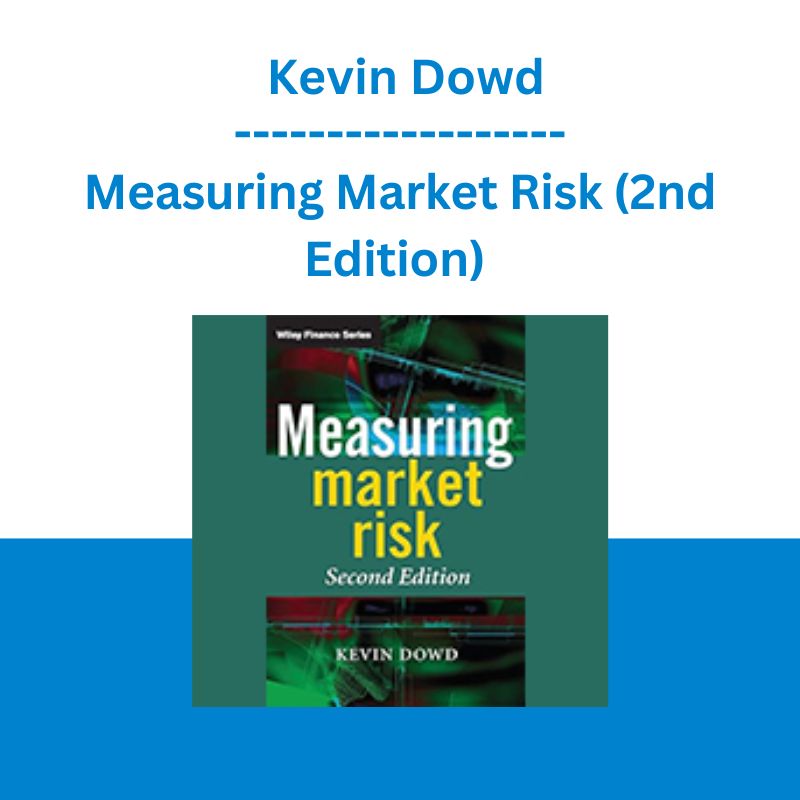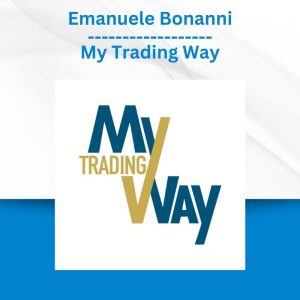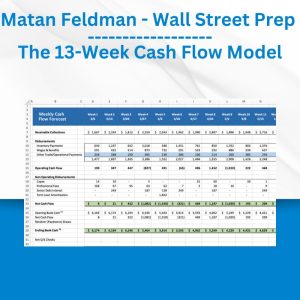*** Proof of Product ***
Exploring the Essential Features of “Measuring Market Risk (2nd Edition) – Kevin Dowd”
Measuring Market Risk 2nd Edition
by Kevin Dowd (Author)
Fully revised and restructured, “Measuring Market Risk, Second Edition” includes a new chapter on options risk management, as well as substantial new information on parametric risk, non-parametric measurements and liquidity risks, more practical information to help with specific calculations, and new examples including Q&A’s and case studies.
From the Inside Flap
The second edition of Measuring Market Risk provides an extensive treatment of the state of the art in market risk measurement. The book covers all aspects of modern market risk measurement, and in doing so emphasises new developments in the subject such as coherent and spectral risk measures, the uses of copulas, new applications of stochastic methods, and new developments in backtesting.The topics covered include: the rise of VaR as a risk measure; different measures of financial risk (including coherent and distortion risk measures); non-parametric approaches (including the bootstrap, order statistics, non-parametric density estimation, and principal components and factor analysis); parametric approaches (including copulas and extreme-value approaches); the theory and applications of stochastic methods; the forecasting of volatilities and correlations; liquidity risk; options risk measurement; risk decomposition; mapping; stress-testing; backtesting; and model risk.
Measuring Market Risk is written in a clear and accessible style, and includes many worked examples of market risk measurement problems.
From the Back Cover
The second edition of Measuring Market Risk provides an extensive treatment of the state of the art in market risk measurement. The book covers all aspects of modern market risk measurement, and in doing so emphasises new developments in the subject such as coherent and spectral risk measures, the uses of copulas, new applications of stochastic methods, and new developments in backtesting.The topics covered include: the rise of VaR as a risk measure; different measures of financial risk (including coherent and distortion risk measures); non-parametric approaches (including the bootstrap, order statistics, non-parametric density estimation, and principal components and factor analysis); parametric approaches (including copulas and extreme-value approaches); the theory and applications of stochastic methods; the forecasting of volatilities and correlations; liquidity risk; options risk measurement; risk decomposition; mapping; stress-testing; backtesting; and model risk.
Measuring Market Risk is written in a clear and accessible style, and includes many worked examples of market risk measurement problems.
About the Author
Kevin Dowd is Professor of Financial Risk Management at Nottingham University. Kevin is an Adjunct Scholar at the Cato Institute in Washington, D.C., and a Fellow of the Pensions Institute at Birkbeck College.
Product details
Publisher : Wiley; 2nd edition
Language : English
Hardcover : 416 pages
Customer reviews
Alfred Wu
great reference in market risk
I think that this book is an excellent book for a person who want to know more stuff about market risk. But it is not
suitable for a person who is new in this field. But if you want to reference something further, it could help you,
I think. To read this book, you may need some fundamental math concept. Basically, it is more theory description than
just concept description. To me, it give me another idea on how to deal with heavy tail VaR. Not just only Normality
VaR that we are familiar with. I read some books about risk managment. seldom authors describe it so detail and clear.
Of course, some math may need numeration analysis , probability, linear algebra. if you want
to implement it in Java, C without other package help. those detail implement methods may need some futher books about
those math which we need to reference. But it is not an easy work. I think this book really help me in this field,
market risk.
Anonymous
One of the best books on VaR, but not suitable for beginners
I fundamentally disagree with the reviewer stating that this book should not be bought. The fact that that reviewer isn’t familiar with Matlab is a shame given that he or she works as a risk manager and since Matlab is often a basic pre-requisite for doing good quantitative finance. Serious risk management demands serious numerical software and Matlab is one such tool which allows quick model implementation in the fast paced business world. Excel/VBA are definitely not suitable for good work in this field (just look up the many statistical problems that can be found in Excel’s functions, for example, or try to implement some basic matrix operations using VBA). C is not great either given that the Dowd’s didactic message would be lost in a sea of imperative coding logic. Not understanding that the ‘svd’ function is shorthand for singular value decomposition, makes me suspect that that reviewer’s quantitative abilities may not at the level needed to read this book. However, I don’t want to turn this review into a flame-fest advocating Matlab over all else and ignoring the content of the book itself. I think Matlab has its faults too, but Dowd made a sensible choice in using this pseudocode-like language for the examples of the models he presents. (And if Matlab is too expensive to purchase there are many free clones that work just as well: just search for ‘scilab’ or ‘octave’ on the web). But on with the review of the book itself…
As I said in the subject heading, this book is not suitable for beginners. There is not much in the way of justification of the aims of VaR or the field of market risk management, while much time is spent on classroom level theory. For example, chapter one contains a very brief recap of the highlights of the history of portfolio risk measurement, while chapter 2 already attempts to rip VaR apart with the justification of using coherent risk measurements instead of VaR. A beginner is just not going to be able to grasp all that’s going on at this early stage without a good number of practical examples. Even *with* the examples, it’s often hard for people new to the field to get the kind of intution that only comes after years of practice and working through real problems. Dowd doesn’t do much to alleviate that kind of confusion. However, for the practicing, well-read risk manager or quant, the book is a veritable encyclopediac reference of the field. Dowd does for VaR what Fabozzi does for fixed income securities. He covers practically all the major models and their many variations and gives much more information about the mathematical tools needed to make these models tick than do most of the classic references (e.g. Jorion). What’s more Dowd does an admirable job of describing important complements to VaR such as stress testing, backtesting, and model risk. Finally, the citations that Dowd includes in the book are useful in and of themselves as they include the main readings in the field.
My biggest complaint with the book is that’s it’s no more than a survey of the *theory* of VaR. To that end, Dowd’s academic focus is present throughout and this focus book does not easily lend itself to practical issues in risk management and analysis. For example, one of the most important practical issues in risk management is the mapping of securities into their building block risk factors, yet Dowd spends a paltry 11 pages discussing this topic. What’s more there is no mention of the very real world need to model portfolio VaR in the case of missing market data. Dowd too often assumes a perfect world of complete data which is simply not the case. Moreover Dowd does not discuss many of the real world issues involved in the development and maintenance of living breating enterprise risk systems.
Overall I think this book is an extremely useful addition to every risk manager’s bookshelf, but I only gave it 4 stars because I feel there is a fair bit of room for improvement.
Please see the full list of alternative group-buy courses available here: https://lunacourse.com/shop/










 George Fontanills & Tom Gentile - Optionetics Wealth Without Worry Course
George Fontanills & Tom Gentile - Optionetics Wealth Without Worry Course  Akil Stokes & Jason Graystone - TierOneTrading - Trading Edge 2019
Akil Stokes & Jason Graystone - TierOneTrading - Trading Edge 2019  Emanuele Bonanni - My Trading Way
Emanuele Bonanni - My Trading Way  The Daily Traders – Exclusive Trading Mentorship Group
The Daily Traders – Exclusive Trading Mentorship Group  Money Miracle - George Angell - Use Other Peoples Money To Make You Rich
Money Miracle - George Angell - Use Other Peoples Money To Make You Rich  Simpler Trading - Bruce Marshall - The Options Defense Course
Simpler Trading - Bruce Marshall - The Options Defense Course  Matthew Kratter - Trader University
Matthew Kratter - Trader University  Forexmentor - Recurring Forex Patterns
Forexmentor - Recurring Forex Patterns  Jesse Livermore Trading System - Joe Marwood
Jesse Livermore Trading System - Joe Marwood  The Glendon Association - Understanding and Preventing Suicide
The Glendon Association - Understanding and Preventing Suicide  Team NFT Money - Ultimate NFT Playbook
Team NFT Money - Ultimate NFT Playbook  SMB - Options Training
SMB - Options Training  Trade Like Mike - The TLM Playbook 2022
Trade Like Mike - The TLM Playbook 2022  Dictionary of Analysis, Calculus, and Differential Equations: A Volume in the Comprehensive Dictionary of Mathematics - Douglas Clark
Dictionary of Analysis, Calculus, and Differential Equations: A Volume in the Comprehensive Dictionary of Mathematics - Douglas Clark  Matan Feldman - The 13-Week Cash Flow Modeling - Wall Street Prep
Matan Feldman - The 13-Week Cash Flow Modeling - Wall Street Prep  Greg Loehr - Advanced Option Trading With Broken Wing Butterflies
Greg Loehr - Advanced Option Trading With Broken Wing Butterflies  Rebecca Jorgensen - EFT Part 2 (Sessions 4-6)
Rebecca Jorgensen - EFT Part 2 (Sessions 4-6)